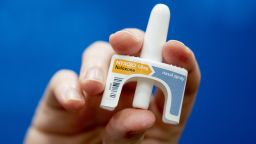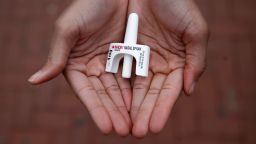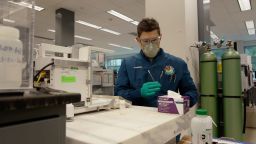The number of young children in the US who have died from opioid overdoses has increased significantly, according to a new study on accidental poisonings of children 5 and younger.
The study, published Wednesday in the journal Pediatrics, looked at a nationwide database and found 731 children 5 and under among poison-related fatalities between 2005 and 2018. Some of the children were poisoned by over-the-counter pain, cold and allergy medicines, but the highest number of fatal poisonings by far were from opioids.
The trend got worse over time. In 2005, opioids accounted for 24.1% (seven of 29) of the substances contributing to child deaths, compared with 52.2% (24 of 46) in 2018.
“It truly is striking to see, looking at this data, how different the proportions were between 2005 and 2018,” said study co-author Dr. Christopher Gaw, an associate fellow at Children’s Hospital of Philadelphia whose research primarily focuses on pediatric injury and poisoning.
The number of deadly poisonings in this age group had been decreasing since the passage of the Poison Prevention Packaging Act in 1970, when harder-to-open childproof packaging became a standard for many medicines, other studies have shown.
Gaw thinks that people’s preferences for particular drugs have shifted and that that has had an impact on fatality numbers.
In the late 1990s and early 2000s, prescription-based opioids were the drug of choice. As guidelines became stricter and more doctors and dentists became aware of the opioid epidemic, they prescribed fewer opioids, so people turned to things like heroin and fentanyl.
Illicitly used drugs like fentanyl, which is 100 times stronger than morphine and can kill quickly, don’t come in childproof packaging.
The new study builds on work that has shown a steady increase in the number of children killed by opioids, alongside rising deaths in adults. Drug overdose deaths have quintupled since 1999, according to the US Centers for Disease Control and Prevention, and nearly 75% of the 91,799 overdose deaths in 2020 involved an opioid.
Medication safety initiatives to cut the number of opioids in circulation have helped reduce opioid use to some extent, but the initiatives can’t address the illicit drug trade, research shows.
The new study can’t explain how the young victims got hold of drugs, but it does offer some details on circumstances in which these deaths happened.
Child protective services departments had open case files for 97 of the children who died. There was a documented history of child maltreatment in 153 of the cases, and nearly a third of those who died with a history of mistreatment were less than a year old.
More than two-fifths of the children who died were infants, less than a year old.
More than 65% of the deaths happened at home. Nearly a third were under the supervision of someone who was not their biological parent.
Of cases in which the circumstances were documented, more than 40% of the deaths were accidental overdoses. A little less than 18% were considered deliberate poisonings.
The researchers on the new study pulled records for all children 5 and younger from the National Fatality Review-Case Reporting System, a database of death records from 40 US states in which a variety of interdisciplinary groups review any child fatality within their jurisdiction. America’s poison centers keep their own data on pediatric poisoning deaths and have found similar trends.
“What we tend to see at the poison center level is that opioids are associated with the most cases of pediatric fatality compared to other substances,” said Kait Brown, clinical managing director of the American Association of Poison Control Centers, who was not involved in the new research.
Brown has also noticed a decline in exposures to prescription opioids like hydrocodone and oxycodone and an increase in fentanyl exposures. Additionally, there’s been an increase in children poisoned by opioid abstinence medications like methadone.
“Most of the time, when the kids are being exposed, it’s accidental,” Brown said. People may keep prescriptions in easy-to-open pill organizers instead of childproof bottles. They may even keep them loose in a pocket, since many of these medicines are for pain. A pill then could fall into the open, where small children could easily find it.
Gaw says most of these young victims probably find drugs as they are exploring the world around them.
“So kids, when they grow and develop, they move around. They explore their environment. They love putting things in their mouth,” he said.
Gaw said it’s important for health care providers to remind caregivers that the best way to keep kids safe is to focus on preparedness and prevention.
“Try to keep dangerous substances, whatever they may be, out of reach, out of sight, out of mind of children, preferably behind a locked cabinet,” he said.
If you have unused medication, you can take it to a pharmacy or another safe-disposal location rather than tossing it into a trash can.
Gaw encourages all caregivers to keep the poison control number handy: (800) 222-1222.
He hopes his study will prompt providers to educate parents about the risks that drugs pose. He also wants to see wider availability of naloxone, the opioid antidote, also known as Narcan. It’s safe for children and can reverse an overdose.
In February, two independent advisory committees for the US Food and Drug Administration voted unanimously in favor of making naloxone nose spray available over-the-counter to increase access. The FDA commissioner has taken those recommendations into consideration and could make a decision any day.
Get CNN Health's weekly newsletter
Sign up here to get The Results Are In with Dr. Sanjay Gupta every Tuesday from the CNN Health team.
Gaw said it is also important for health systems to continue finding ways to limit how many opioids are in a young child’s environment. And if adults with substance use disorders get help, he says, the child will be helped too.
“It is incredibly sad, but I think it’s important to really highlight because we don’t want children to be forgotten in this epidemic, because they’re also at risk,” Gaw said. “Their risk is related to the larger world that they’re in.”
Health - Latest - Google News
March 09, 2023 at 04:12AM
https://ift.tt/q8B7MrP
Young children are increasingly victims of opioid epidemic, study finds - CNN
Health - Latest - Google News
https://ift.tt/36mxG5j
Bagikan Berita Ini



















0 Response to "Young children are increasingly victims of opioid epidemic, study finds - CNN"
Post a Comment